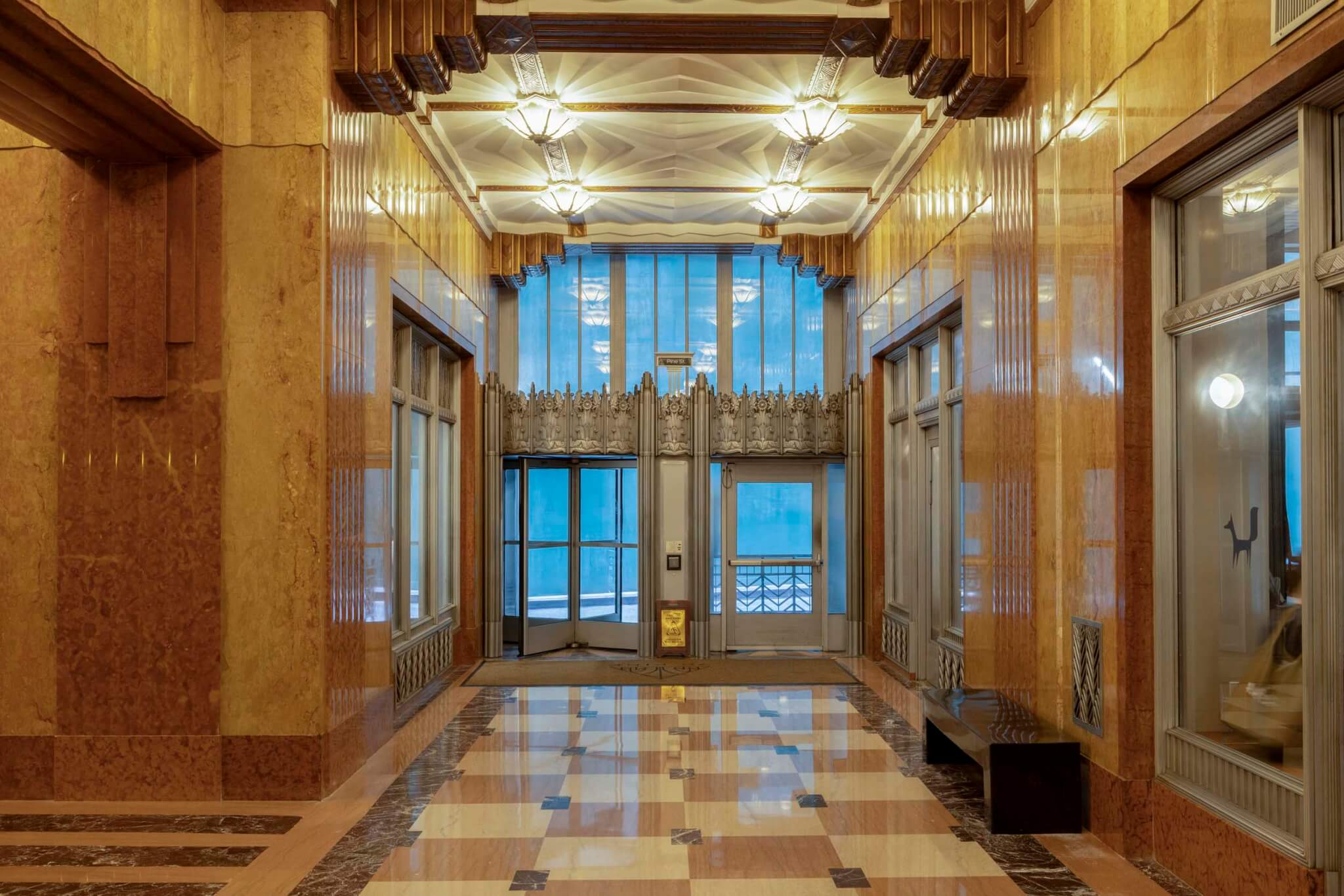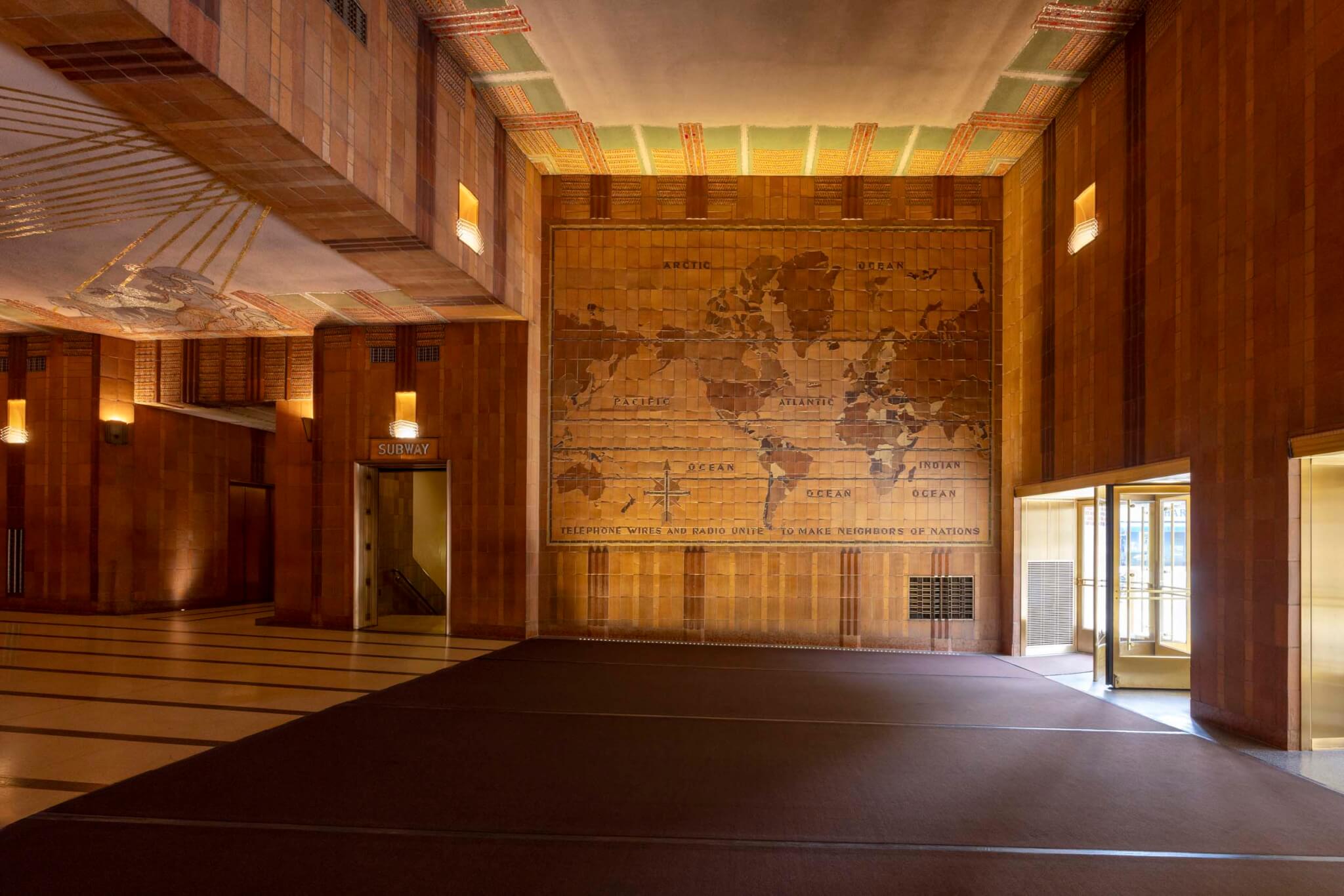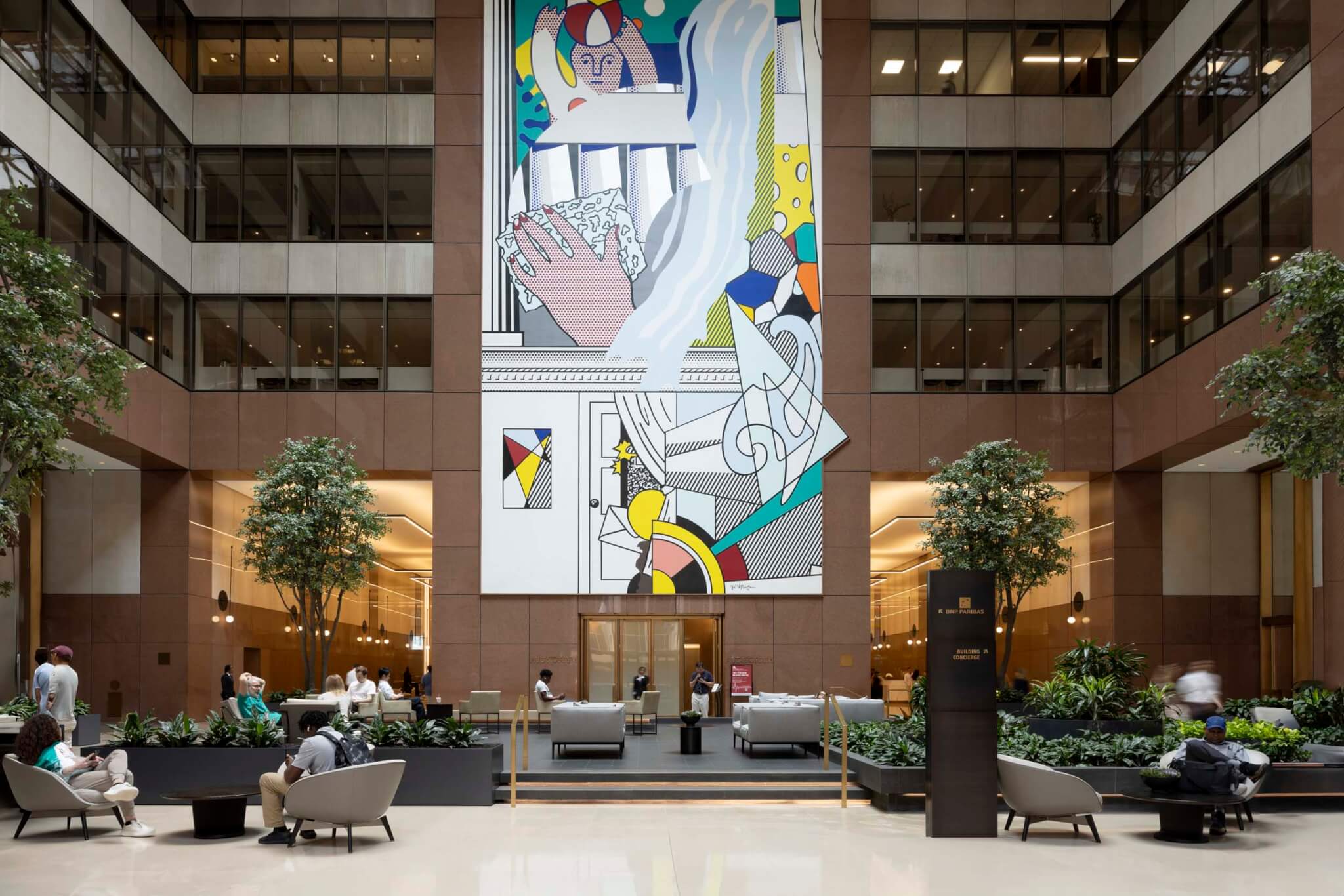Everyone uses lobbies but almost always as a passage to somewhere else. You’re on the way to your own apartment or someone else’s; you’re off to work or to an appointment.
There’s a sort of inchoate social norm that lobbies are a place where you don’t belong unless a social or business transaction awaits. This is incorrect: Lobbies are for everyone! You might not be able to get farther into the building, but the interior entrance area, usually accessible, gives you a good whiff of what’s around the corner. Why explore lobbies? They are the concentrated charm offensive in a building. No one would put all of the marble or chrome in their home into a foyer; many towers do. Lobbies are often the sole interior space in a high-rise where architects can have any fun at all. Every other floor tends to be the same thing or barely detailed from the start.
My personal gawking habit ramped up during those tedious COVID-19 months, when I reached a certain explorer’s frustration with a New York where other “rooms” beyond the streetscape consisted only of retail or civic structures. Of course, I was already lobby-curious: I had Wirt C. Rowland’s Guardian Building in Detroit as the background on my phone for years before finally scoring a visit. (Who said dreams don’t come true?) I often find myself killing time in New York, and there are only so many coffees or martinis you can drink before endangering whatever you’re going to do next. The solution awaits behind revolving doors.
My advice isn’t novel; travel guides will tell you to go inside 30 Rockefeller Plaza (now newly primped) and the Empire State Building, but neither tourists nor guidebooks universalize the logic. Skyscrapers are things everyone aims to see in any city. This is almost always done purely from outside. I grasp the reason why: We fear Cerberus the doorman, or at least his many-eyed stare. My appearance almost never meets the minimal standards of business casual, so I have understandably received the tramp treatment more than once. I have been briskly turned out of the Chrysler and Woolworth buildings and fancy spots along Central Park. Yet I regularly succeed in taking a look around.
How to Sneak into Lobbies
Once across the threshold, the vital first step is to explain to the person behind the security desk what you’re doing. They will often be baffled but usually assent. The lobby gawker is an easier guest than someone who needs a building ID. Ask a friendly question, and you’ll frequently get a quality story about the space from the person who knows it best. Their job in almost every case is to ensure that people like me don’t get beyond the lobby; hanging out in this interstitial space is just fine. (Like purgatory, it works for a limited time.) I won’t deny that a certain illicit thrill comes with the victory of a successful snoop.
Read any book about a skyscraper and a handful of pages, paragraphs, or photos are usually all you get on its lobby. (Unless, of course, your freak is fancy Italian domiciles, and then your drug of choice is Karl Kolbitz’s Entryways of Milan.) Lobbies are often the most public interior component of a large building and offer a liminal mixing chamber where all types of people collide. They are social condensers of sorts, these days replete with laptop warriors, delivery people, caffeine fiends, and curious spectators. This capacity goes underexplored in accounts of large buildings.
Serge Chermayeff explained in a 1964 piece in Architectural Forum that the lobby “imprints upon the spectator’s mind and eye the character and quality of the building and its organization—if it has either.” It’s the sole opportunity to make a splash. Plenty of buildings make only a thud, but those that soar can achieve a sublimity that remains in place for well over a century.
Louis Sullivan, in essentially the first treatise on skyscraper design—his 1896 Lippincott’s Monthly Magazine piece, “The Tall Office Building Artistically Considered”—devoted a morsel of consideration to their lobbies, explaining that they ought to be treated “in a more or less liberal, expansive, sumptuous way … expressed with a sentiment of largeness and freedom.” William F. Lamb, best known for working with his pals Shreve and Harmon, wrote in Architectural Forum in 1924 that the lobby “presents one of the very few opportunities in the interior of a commercial building when one may polish up the harness and drive one’s thoroughbreds in the ring.”
A Beginner’s Guide to Architectural Lobby Snooping
The harnesses are polished to an enormous sheen at many locations in New York. Cross and Cross’s 570 Lexington Avenue features metal ornament that’s very deco set against marble shades that usually aren’t—pink, black, and red. (A favorite detail: the mailbox shaped like the tower.) The office’s 20 Exchange Place is another stone smorgasbord; sylphs adorn the silver nickel elevator doors. Clinton & Russell, Holton & George’s 70 Pine Street, offers two floors of harlequin and is open as a preamble to the building’s fine-dining options. There are many rote ways to get people to elevators; there are also highly imaginative ways to do it. Consider the transparent arrangement of elevator bays at Mies’s Seagram Building (which you can step into) compared with any of those above. Sometimes you are channeled through a passage; at other points you are not.

Many eras offer highlights. James Ingo Freed’s 499 Park Avenue, completed in 1980, contains a single Zen ficus framed by black granite. It’s a great spot to watch the light shift. My luck has varied at Gordon Bunshaft’s Lever House. (Some doormen are friendly, some are not.) Remember that no one will prosecute you for trespassing if you merely try. Follow your nose: If a building looks attractive outside, there’s a good chance its splendor continues inside.
The options for finding great architectural design in lobbies continue across the country. I began my exploring near home in Pittsburgh. There’s a John LaFarge stained glass window in Daniel Burnham’s Frick Building. Other lobbies there reveal depths of character that exteriors do not. Harrison & Abramovitz’s Alcoa Building lobby feels slightly older than its peak midcentury modern aluminum panel exterior; you can almost see the modern butterfly emerging from the deco chrysalis right there. There are numberless photos of Johnson/Burgee’s black mirrored glass at PPG Place, but even plenty of locals have no idea about the Red Queen camp lobby spectacle inside. It’s vital to see Frank Lloyd Wright tweaking Burnham at the Rookery in Chicago. I love the floral polychrome ceiling at Miller and Pflueger’s 140 New Montgomery in San Francisco. Obviously, you’d always try for Sullivan and Burnham interiors; don’t sleep on Yamasaki or Jahn. Don’t neglect the megafirms, either. The BNY Mellon Center in Philadelphia is a welcome artifact from Kohn Pedersen Fox’s postmodern glory days. You can find small gems in lobbies anywhere: a midcentury steel sculpture in Little Rock or a mural in what’s now a public housing tower in Youngstown, Ohio. Don’t just look at buildings; look in them.
There’s an archaeological layer; many lobbies reflect intentions to impress from bygone enterprises. Banks in pre- FDIC days were very keen to flash their costly suit linings. If a company used ten different kinds of marble in its lobby, you might trust that company with your money. One can see this in almost every city, even as the uses have changed. (In San Antonio? Check out the Drury Plaza Hotel, formerly a banking hall.) Telephone companies also went all out. As a doorman in Ralph Thomas Walker’s Barclay-Vesey Building once told me with a laugh, back then “there was only the one telephone company—they had all the money.”

A Not-so-Secret Goldmine for Art Appreciation
Lobbies are also time-honored venues for seeing Big Art. Hildreth Meière has many fantastic pieces in the interior of Walker’s 32 Avenue of the Americas; it’s one of few places you’ll find a kangaroo on a ceiling. (Her dazzling mosaic work is now accessible in Printemps’s Red Room, also designed by Walker.) Roy Lichtenstein’s Mural with Blue Brushstroke at Edward Larrabee Barnes’s 787 7th Avenue is possibly the largest work he ever executed and was designed precisely for that spot—and the masonry wall’s joints continue across the canvas. Harrison’s 717 Fifth Avenue contains a Josef Albers mural in marble and gold leaf that was important enough that the architect offered to pay for it himself (according to Victoria Newhouse’s monograph on the architect). Albers’s monumental Manhattan towers over the concourse below the MetLife Building, and he has yet another piece lining an elevator bay in Harrison & Abramovitz’s 1271 6th Avenue.

New buildings don’t always do this to good effect, but sometimes they do. The Sol LeWitt inside Norman Foster’s 425 Park Avenue is good, whatever you might think of the rest of it. Christopher Wool has improved SOM’s already very fine 2 Manhattan West lobby. A fantastic Julie Mehretu graces the interior of the new Goldman Sachs HQ at 200 West Street, designed by Pei Cobb Freed & Partners, but sadly it can only be ogled from outside.
The task is sometimes dicier in residential buildings, but still worth it. A number of the aforementioned buildings are now residences. These have a built-in alibi for poking around, as you could easily be an interested renter or buyer.
The existential fragility of lobbies lends the best ones an urgent appeal. They can easily be ripped out—or “refreshed” or “repositioned”—due to the competitiveness of real estate operators. It doesn’t require black-and-white photos to know what we’ve lost. Kevin Roche’s 60 Wall Street lobby and Raymond Hood’s McGraw-Hill interior were vandalized recently, and Isamu Noguchi’s Ceiling and Waterfall for the lobby of 666 Fifth Avenue was removed in 2020 ahead of a full-building renovation led by KPF.
Amid the siloing of society into narrow slivers of privatized attention and audience, a small act of resistance is to refute the idea that a lobby is only for those who live or work in a building. They are—or ought to be—for everyone. Of course, the people who use a building benefit from a grand lobby every day, but its spatial thrill can be yours even if you don’t exactly have any business being there. After all, your boss isn’t waiting at the other end of the elevator.
Anthony Paletta is a writer living in Brooklyn.
→ Continue reading at The Architect's Newspaper
